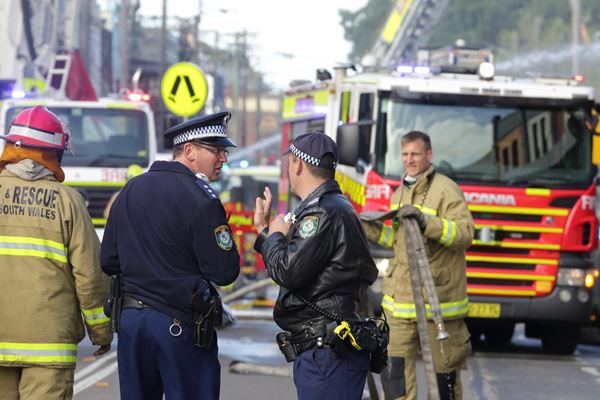Fire Protection Systems Need Fire Protection Engineers

Fire protection systems are often the silent and forgotten part of a structure until the moment they are needed. We rely on fire protection systems to aid in alerting occupants, calling for help, extinguishing or slowing the fire, and containing the danger if possible. When the systems do not achieve these goals, then what? Besides the possibility of lives lost and damage to property, what should investigators look for during an origin and cause investigation? What are the recovery avenues?
Automatic fire sprinklers are one of many types of fire protection systems. According to National Fire Protection Association (NFPA) data, when fires are large enough to activate automatic sprinklers, they function as designed approximately 92% of the time. Approximately 60% of the fires where the sprinklers failed to operate, were due to the system being shut off.1
Fire Protection and Notification Systems
The vast spectrum of fire protection and notification systems are typically designed and installed in response to building code requirements. These can encompass hazard classifications, code requirements, or requests made by an owner when deciding on which system to implement.
Automatic extinguishing systems (AES) can include:
Wet Pipe, Dry Pipe, and Deluge Sprinklers
Wet pipe sprinkler systems are the most widespread active systems in use today. They consist of water-filled piping with individually activated sprinklers within a building designed to provide a specified density of water spray when thermally activated. Wet pipe systems are monitored for water flow, which are read by the monitoring company as a fire alarm. They are also monitored for valve tamper, which will alarm should the water supply valve close.
Dry pipe sprinkler systems are similar to wet pipe sprinkler systems, as they possess individual thermally activated sprinklers. The piping and sprinklers within the system may be located in areas subject to freezing temperatures, so the pipes are pressurized with low-pressure air to prevent freezing from happening. When activated, a valve at the base of the water supply riser opens as the air pressure drops, flooding the system. In addition to water flow and valve tamper, these systems are monitored for low air pressure. Low air pressure occurs when there is a leak large enough that the air maintenance device cannot keep up with pressurizing the system. Response to a low air pressure alarm may save the system from falsely tripping when only an air leak is present.
Deluge water spray systems are found at hazards where a rapid-fire development is expected, such as chemical processing facilities, large transformers, highway tunnels, or fuels processing/distribution. These systems are activated either by heat or smoke detection and have open sprinklers where all the heads spray at once. They are monitored for similar alarm and trouble points to a wet pipe system, but the releasing systems have additional monitoring points, like loss of main power, ground fault, and supervisory air.
High and Low Expansion Systems
High and low expansion systems typically protect facilities where hydrocarbon fuels are present and subject to pooling. This includes aircraft manufacturing and repair, truck repair, and fuel processing or storage. Both high and low systems are similar, each using a water-based foam to smother a fire. The low expansion foams have an air to water ratio of 20:1 or less, and high-expansion foams have an air to water ratio of greater than 20:1. Water is supplied to the systems using deluge valves and fast-acting control valves with proportioning mechanisms to deliver the foam/water mixture to foam generators. The foam generators are located above the hazard and use blowers to form the foam, which blankets the protected hazard quickly, cools the fire, and forms a layer to exclude oxygen.
UL 300 and Dry Chemical Extinguishing Systems
The wet agent version of UL 300, or dry chemical extinguishing systems, use a water-based soap-like solution. These are typically used for areas like commercial kitchens, paint spray booths, or another special hazard. The dry chemical type is similar to a fire extinguisher. Both use pressurized gas to push the agent out of storage tanks, but UL 300 uses piping, as opposed to nozzles, at the protected hazard. The protected hazard is then blanketed with the medium. Additionally, these systems are designed to shut off fuel to the cookline or hazard, and newer installations include an activation alarm.
Gaseous Agent Systems: Carbon Dioxide, Halon/Replacement Agent
Gaseous agent systems are used for protection of hazards that are susceptible to severe damage from water. This can include printing presses, computer servers, and power generation equipment. The systems are specifically designed to blanket the hazard at a specific density and for a specific amount of time and are typically activated by smoke, heat, or flame detection. Monitoring points vary depending on the detection system used but can include system discharge, backup battery failure, power failure, or processing system trouble.
All of these systems are subject to design and routine testing and maintenance per NFPA specifications. It is the property owner’s responsibility to provide proper testing and maintenance, but responsibility for these functions can be contracted to a knowledgeable entity. It is important to determine who provided what maintenance on which system and how often. The records will be critical to the analysis.
Monitoring and Notification
Although all fire protection systems are typically activated and monitored by a detection or alarm system, these systems can vary just as much in structure as the fire protection system. They can provide vital information regarding the timeline of a fire and its progression, and any problems that occurred with the system before or during the incident.
Simple fire protection systems can monitor smoke detection, have manual pull stations, and deploy sprinkler water flow. They can also record trouble conditions, such as loss of power or internal failures of alarm initiating devices (smoke detectors, for example) or wiring. This information can be used to determine where the fire was first noted and at what time.
More complex systems can include multiple reporting data points relative to the type of system employed. For example, very early smoke detection apparatus (VESDA) systems, which use a powered vacuum pump to sample atmospheric conditions at multiple points within a facility, can monitor background particulate levels at various diameters. The systems can report how much and what type of particulate matter was in the air before the fire began, as well as during its incipient growth phase. This provides invaluable information for origin and cause analyses and determinations.
Origin and Cause Investigations
During a fire scene investigation, the investigator needs to not only focus on the fire-damaged area when identifying potential failures of equipment but the overall structure and property. The investigator should look for why the fire spread the way it did and how it relates to not only the origin and cause but to the detection and suppression systems in place.
Since fire investigators are generally the first forensic investigators at a loss, their initial photographic documentation can be extremely important. Securing the loss site is also essential to the preservation of evidence and the mitigation of spoilation potential. That being said, having an investigator on the site as soon as possible plays a major role in completing these initial tasks.
Information regarding the activation of a building fire alarm system can also be obtained by neighborhood cavasses and interviews with the tenant or employees. Once a system is activated, audio and visual notifications are made to those in the area by way of strobes, tone alerts, and/or verbal directions, depending on the system setup. Automatic extinguishing systems with water flow alarms also provide audio notification both inside and outside a structure. During interviews, investigators should find out what was heard or observed by the occupants or neighbors before or during the incident. Many times, people will take photographs or videos with their phones, which can provide documentation regarding the activation or function of the system and aid in the timeline of events during the incident.
Subrogation Considerations
While fire protection systems are usually not the direct origin or cause of the fire, should a system fail to activate correctly, there is potential for liability against the system manufacture or the contractor for potential negligence or product defects. Each U.S. state has different rules regarding such subrogation. The cause of action against any contractor or manufacturer is likely secondary, meaning it was not the cause of the fire, only that the system failed and allowed the fire to spread, causing additional damages. Such actions are often governed under the superior equities rule.
For example, in subrogation litigation in California, the doctrine of superior equities is critical in determining whether a right of subrogation exists.2 This restrictive principle prevents an insurer from recovering against a party whose equities are equal or superior to those of the insurer. This doctrine is usually invoked in the context where the insurer is seeking to subrogate against third parties who are not other insurers. Cases against parties who were not the original tortfeasor can be subject to this rule.
A legal analysis of each set of circumstances is likely needed to determine whether subrogation exists. Should it exist, an origin and cause investigator must document the system and provide an opinion on the fire’s spread and additional damages incurred due to the system's failure. If the system was functioning properly, likely no cause of action against the fire protection system exists.
Fire Protection Engineering
When a fire protection system fails or a fire loss occurs, a fire protection engineer is able to amplify and refine detection, suppression system, and activation system data. Once the time stamp information is correlated, detection system information can be used to determine how large the fire likely was once it was detected and what type of material was likely burning. Activation and control system timing and reporting points also become useful for determinations of when the extinguishing system was activated. Design criteria can be cross-correlated to the probable effects of dampening down the fire or failure to dampen.
Detection and alarm system data can also be used by fire protection engineers for modeling purposes. Along with structural parameters, such as wall, ceiling, and floor construction, various configurations and timeframes for known system activations versus hypothetical conditions can be analyzed via computational modeling. This aids the scientific method process of fire analysis and can help reduce error and eliminate unwarranted hypotheses from consideration, refining conclusions of causality.
Thank you to co-author Jordan Everakes, Partner at Grotefeld Hoffmann.
1 S. Experience with Sprinklers, Aherns, July 2017, NFPA#USS14-REV
2 Jones v. Aetna Casualty & Surety Co., supra, 26 Cal.App.4th at p. 1724; Rokeby–Johnson v. Aquatronics International., Inc. (1984) 159 Cal.App.3d 1076, 1084.
Our experts are ready to help.




